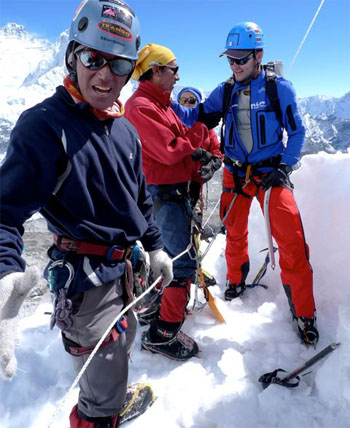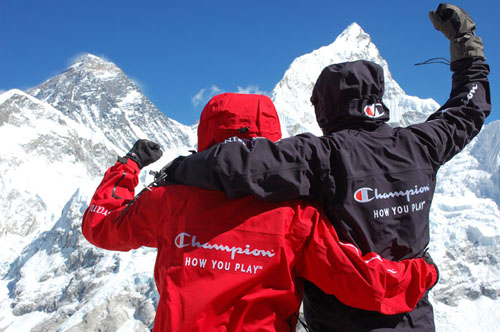By STEPHANIE PEARSON
For Mike Abbott, the 46-year-old director of research and development for Hanesbrands, trekking as high as 18,400 feet on his recent trip to Mount Pumori in Nepal was tough. “It was more mentally challenging than I ever thought it would be,” says Abbott, “but I’d go back in a second.” Abbott spent almost a month in Nepal with Jamie Clarke and the Expedition Hanesbrands climbing team field-testing Champion and Duofold technical gear that he’s spent the last two years designing. His R&D takeaway: “In some cases I designed a Ferrari and learned that I can’t drive it on the interstate,” he says. “But in some cases we got it just right.”
Pearson: What was your goal for the trip?
Abbott: For me personally it was to make it to base camp and not hold everyone up. Professionally, it was to learn what it was like to be at altitude for a long period of time and the difference between what gear you need for trekking versus what you need for climbing.

Pearson: How did you fare at altitude?
Abbott: I live in North Carolina and love to hunt, fish, and ride my mountain bike, but I’ve never trekked for eight hours at a time in my life. My normal heart rate is about 55. In the Himalaya it was 85. My oxygen saturation percentage was in the low 80s, which was pretty good. I lost 18 pounds even though everything I ate had peanut butter on it.
Pearson: What gear did you get right?
Abbott: One piece of gear that I originally thought was a disaster was our soft-shell pant. I thought it looked like a pair of pajamas, but everyone wore it all day long. Functionwise, it was great. Appearancewise, I was never really happy with it. The bright blue soft-shell jacket got more use than any other garment. It blocked the wind, had enough stretch, didn’t rub on our arms, and the pocket placement was really good.
Pearson: What gear still needs work?
Abbott: The most basic thing is that we didn’t put pockets in the right places because we were trying to adjust for climbing harnesses. But 90 percent of the time you’re not on the mountain and you just want a warm place to stick your hand. By the end of the trip, if one more person said anything else about pockets to me, I was going to kill them. We also made an expedition toboggan, or tuk, that looks like a football helmet. Several people wore it at night for sleeping because of its good, snug fit, but it came down around your cheeks, so it looked like a 1940s leather football helmet.
Pearson: How did the summit suit work?
Abbott: As you can imagine, the summit suit and its warmth without bulk functionality is still a work in progress. We are very far along with it, and it will be the most technologically advanced and challenging piece of apparel gear we develop. We learned quite a bit on Pumori, and we will continue to test new refinements in the Canadian Rockies this winter. We had some technical difficulties with it at altitude, which is exactly why we wanted to field test it in the Himalaya. After examining a few thermal images back in my lab, we’ve found a simple, elegant solution.

Pearson: What was your favorite part about Nepal?
Abbott: The Nepalese people were most amazing. No matter where you went, no matter what you did, the Sherpas were continually glad to see you. If you sat down with them, they asked a lot of sincere questions without apprehension. Their work ethic is beyond anything I could’ve imagined.
Pearson: What was your overall takeaway from the trip?
Abbott: Gearwise, it was the importance of staying dry. You’re going to sweat and having the right gear to keep your base layer dry is absolutely paramount. You can insulate all you want, but if you’re wet, you’re miserable. I also learned that you’re never comfortable and nothing is easy, but I’d still go back in a second.
—Stephanie Pearson is a contributing editor for Outside magazine. This article appeared on https://www.climbwithus.com.






